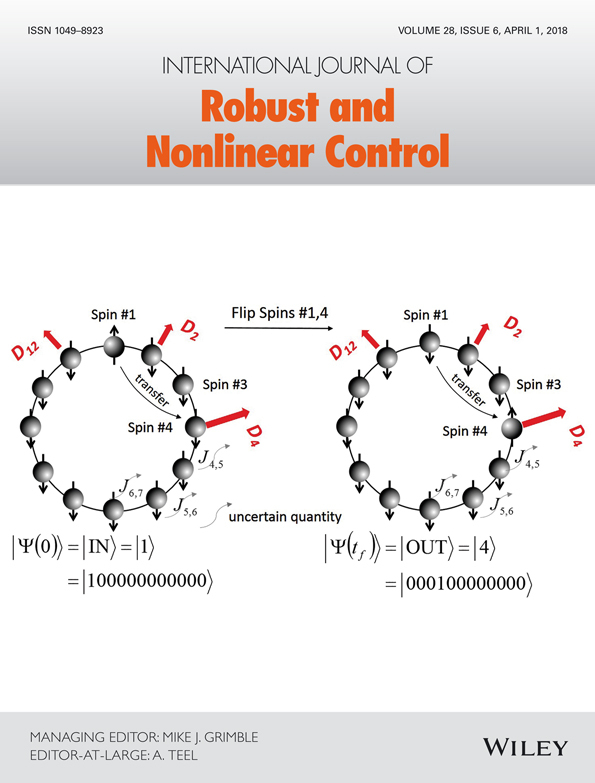An impulsive-switched-system approach to aperiodic sampled-data systems with time-delay control
Weiwei Ma
School of Mathematical Sciences, Shanxi University, Taiyuan, China
Search for more papers by this authorCorresponding Author
Xinchun Jia
School of Mathematical Sciences, Shanxi University, Taiyuan, China
Correspondence
Xinchun Jia, School of Mathematical Sciences, Shanxi University, Taiyuan 030006, China.
Email: [email protected]
Search for more papers by this authorFuwen Yang
Griffith School of Engineering, Griffith University, Southport, Queensland, Australia
Search for more papers by this authorDawei Zhang
School of Mathematical Sciences, Shanxi University, Taiyuan, China
Search for more papers by this authorWeiwei Ma
School of Mathematical Sciences, Shanxi University, Taiyuan, China
Search for more papers by this authorCorresponding Author
Xinchun Jia
School of Mathematical Sciences, Shanxi University, Taiyuan, China
Correspondence
Xinchun Jia, School of Mathematical Sciences, Shanxi University, Taiyuan 030006, China.
Email: [email protected]
Search for more papers by this authorFuwen Yang
Griffith School of Engineering, Griffith University, Southport, Queensland, Australia
Search for more papers by this authorDawei Zhang
School of Mathematical Sciences, Shanxi University, Taiyuan, China
Search for more papers by this authorSummary
This paper devotes to the stability of aperiodic sampled-data systems with time-delay control, where the delays can impose a positive effect on the stability of the systems. The systems are modeled as impulsive switched systems with fixed switching laws. A novel separation theorem is presented to determine the Schur property of a matrix product and then used to obtain a less conservative stability criterion for the impulsive switched systems with fixed switching laws. By the separation theorem and a loop-functional approach, some new stability and stabilization criteria for aperiodic sampled-data systems with time-delay control are provided in terms of linear matrix inequalities. Finally, the stability and stabilization results are tested on some classical numerical examples to illustrate the efficiency of the proposed method.
REFERENCES
- 1Maalouf AI, Petersen IR. Finite horizon H∞ control for a class of sampled-data linear quantum systems. Int J Robust Nonlinear Control. 2017; 27: 2292-2302.
- 2Hetel L, Fiter C, Omran H, et al. Recent developments on the stability of systems with aperiodic sampling: an overview. Automatica. 2017; 76: 309-335.
- 3Huang S, Cai M, Xiang Z. Robust sampled-data H∞ control for offshore platforms subject to irregular wave forces and actuator saturation. Nonlinear Dyn. 2017; 88(4): 1-17.
- 4Zhang W, Branicky MS, Phillips SM. Stability of networked control systems. IEEE Control Syst Mag. 2001; 21: 84-99.
- 5Zhang D, Han Q-L, Jia X-C. Observer-based H∞ output tracking control for networked control systems. Int J Robust Nonlinear Control. 2014; 24: 2741-2760.
- 6Liu K, Fridman E. Wirtinger's inequality and Lyapunov-based sampled-data stabilization. Automatica. 2012; 48: 102-108.
- 7Liu K, Fridman E. Networked-based stabilization via discontinuous Lyapunov functionals. Int J Robust Nonlinear Control. 2012; 22: 420-436.
- 8Fridman E. A refined input delay approach to sampled-data control. Automatica. 2010; 46: 421-427.
- 9Zhang H, Zheng X, Yan H, Peng C, Wang Z, Chen Q. Codesign of event-triggered and distributed H∞ filtering for active semi-vehicle suspension systems. IEEE/ASME Trans Mechatronics. 2017; 22: 1047-1058.
- 10Fridman E, Seuret A, Richard JP. Robust sampled-data stabilization of linear systems: an input delay approach. Automatica. 2004; 40: 1441-1446.
- 11Lee L, Liu Y, Liang J, Cai X. Finite time stability of nonlinear impulsive systems and its applications in sampled-data systems. ISA Trans. 2015; 57: 172-178.
- 12Naghshtabrizi P, Hespanha JP, Teel AR. Exponential stability of impulsive systems with application to uncertain sampled-data systems. Syst Control Lett. 2008; 57: 378-385.
- 13Seuret A. A novel stability analysis of linear systems under asynchronous samplings. Automatica. 2012; 48: 177-182.
- 14Seuret A, Briat C. Stability analysis of uncertain sampled-data systems with incremental delay using looped-functionals. Automatica. 2015; 55: 274-278.
- 15Zhang D, Yang Y, Jia X, Han Q-L. Investigating the positive effects of packet dropouts on network-based H∞ control for a class of linear systems. J Franklin Inst. 2016; 353: 3343-3367.
- 16Mazenc F, Mondié S, Niculescu SI. Global stabilization of oscillators with bounded delayed input. Syst Control Lett. 2004; 53: 415-422.
- 17Khalil HK. Nonlinear Systems. 3rd ed. Upper Saddle River, NJ: Prentice Hall; 2002.
- 18Li Z, Soh Y, Wen C. Switched and Impulsive Systems: Analysis, Design and Applications. Berlin, Germany: Springer-Verlag Berlin Heidelberg; 2005.
10.1007/b100366 Google Scholar
- 19Huang S, Xiang Z, Karimi HR. Input-output finite-time stability of discrete-time impulsive switched linear systems with state delays. Circuits Syst Signal Process. 2014; 33: 141-158.
- 20Huang S, Li X, Xiang Z. Anti-windup design and l2-gain analysis for a class of discrete-time impulsive switched systems with actuator saturation. Trans Inst Meas Control. 2016; 38: 425-434.
- 21Briat C, Seuret A. A looped-functional approach for robust stability analysis of linear impulsive systems. Syst Control Lett. 2012; 61: 980-988.
- 22Liu K, Fridman E, Johansson KH. Networked control with stochastic scheduling. IEEE Trans Autom Control. 2015; 60: 3071-3076.
- 23Li X, Song S. Stabilization of delay systems: delay-dependent impulsive control. IEEE Trans Autom Control. 2017; 62: 406-411.
- 24Li X, Cao J. An impulsive delay inequality involving unbounded time-varying delay and applications. IEEE Trans Autom Control. 2017; 62: 3618-3625.
- 25Li X, Zhang X, Song S. Effect of delayed impulses on input-to-state stability of nonlinear systems. Automatica. 2017; 76: 378-382.
- 26Kao CY, Fujioka H. On stability of systems with aperiodic sampling devices. IEEE Trans Autom Control. 2013; 58: 2085-2090.
- 27Mirkin L. Some remarks on the use of time-varying delay to model sample-and-hold circuits. IEEE Trans Autom Control. 2007; 52: 1109-1112.




